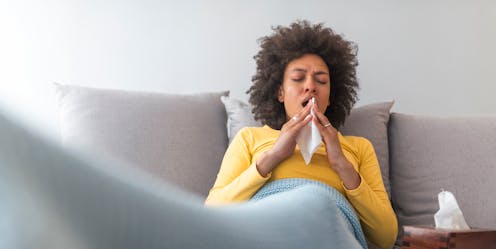Source: The Conversation (Au and NZ) – By John D Blakey, Adjunct Clinical Associate Professor – Curtin Medical School, Curtin University

Hay fever (also known as allergic rhinitis) is a catch-all term that covers a group of ailments that cause sneezing, a runny nose, and itchy and red eyes.
Hay fever affects millions of people in Australia. Ask your friends and colleagues about hay fever and chances are several will report they have it. However, they will probably describe different triggers, symptoms and seasons when it occurs.
Although it may seem like more of an annoyance than anything else, uncontrolled hay fever can have economic and further health effects.
Hay fever can reduce people’s ability to concentrate, for example when driving or at work or school. This is made worse with hay fever also leading to disturbed sleep, affecting mood.
Nasal inflammation from allergies also has a concerning impact on an individual’s defences against infection. The inflammation from hay fever and the need to mouth breathe has a direct impact on asthma, leading to worse symptom control and a greater risk of a flare-up that requires unscheduled health care.
To reduce these risks, a range of treatments are available. However, before considering treatment, we need to consider what’s going wrong and why.
What is hay fever?
In addition to genetic factors, environmental exposures such as airborne pollutants can dramatically predispose people to allergies.
Common causes
Causes of hay fever fall in three main groups:
-
seasonal: pollens and plant materials that give symptoms at certain times of the year. Calendar charts of the various pollens are available
-
perennial/symptoms year round: however clean your house is, you will be exposed to fungal spores and to faeces from dust mites feeding off your dead skin cells. That sounds unsettling enough, but they can both be potent allergens that can’t be effectively avoided
-
intermittent: most typically these are animals’ dead skin. It’s worth noting the culprits are molecules in saliva, sweat and urine, not hair.
What treatments are best for hay fever?
Given these serious consequences, it’s reassuring to know there are effective treatments for hay fever. These range from common over-the-counter products to specialist medicines.
Antihistamines
Many people will immediately think of antihistamines for hay fever: by tablet, nasal spray or eye drops. Histamine is a key messenger chemical in the allergy process, but it isn’t the only one. Therefore, antihistamines alone are usually usually only sufficient to get on top of mild problems.
There are a large number of antihistamines available with a range of effectiveness. Although many are available without prescription, bear in mind some are sedating, and some are unsafe in pregnancy, or when you have certain cardiac conditions, and may clash with some other medicines.
Nasal treatments
Nasal sprays apply treatment directly to microscopic hairs in the nose, helpfully spreading the medicine around. Many people take over-the-counter nasal corticosteroid spray to dampen down inflammation.
As a physician I’ve found it’s common in clinic for people to say sprays “don’t work” for them but usually this is because they don’t take them properly. These treatments can take many days to work, and need to be taken regularly every day. The trick is: don’t sniff them (the medicine will end up in the back of your throat), or spray them onto the sensitive middle part of the nose, which can bleed.
Saline sinus rinses can be very helpful in clearing mucus, allergens and inflammatory material (snot, to you and me) before using other medicines. Always use sterile liquids for this or nasty sinus infections can occur.
Read more:
Sneezing with hay fever? Native plants aren’t usually the culprit
Decongestants
Decongestants might seem like a good idea when you can’t breathe, but are associated with a rebound worsening of swelling when they wear off (this has the excellent name of rhinitis medicamentosa).
As for many chemicals, if you take them long enough the body switches off its own supply (negative feedback) so when the drug is removed, the body is worse off. Think about how someone feels if they haven’t had a coffee all day and normally drinks four or five cups. There is a rebound of blood vessel dilation and mucus production. Use them sparingly.

shutterstock
Prescribed therapies
If your hay fever is more severe, your doctor could consider a course of higher-strength nasal steroid drops, but these aren’t to be used for longer than a month as they can cause erosion of the nasal lining.
Adding a medicine that acts on other key messengers of inflammation (leukotrienes), such as montelukast, can sometimes be helpful. These tablets are usually well tolerated but can have side effects such as headache which lead to their discontinuation.
Validated scores that ask a standard set of questions about aspects of someone’s symptoms (such as “SNOT-22”) are helpful in assessing who needs extra prescription-based treatment for hay fever and their response to it.
Specialist treatments
For people with hay fever alongside asthma or other allergic disease, there are now effective medicines that block messengers of allergy in a highly specific manner, such as the monoclonal antibody Dupilumab, and more are coming soon. Although too costly to be prescribed in hay fever alone, they show our understanding of the relevant mechanisms has improved.
Giving people a regular small dose of something they are sensitised to can make their immune system more tolerant of it. This is often referred to as immunotherapy, and can be by regular tablet or injection.
Read more:
I’m considering allergen immunotherapy for my hay fever. What do I need to know?
Although potentially very helpful, this treatment takes years and many people don’t complete their course. The improvements seen are incremental rather than a complete permanent resolution.
This article does not constitute specific medical advice. Please do speak to your GP, specialist or pharmacist about using the medicines mentioned here. You may also wish to review the helpful information and videos from Asthma Australia
![]()
John Blakey and/or his employer has received funding for research or educational activities from companies that produce treatments for asthma, including Astra Zeneca, Boehringer Ingelheim, Chiesi, GSK, Novartis, Sanofi and Teva. He is affiliated with Asthma Australia and Asthma WA in a medical advisory capacity for which his organisation receives income. He is the WA branch president of the Thoracic Society of Australia and New Zealand. None of these entities had any input into or influence on this article.
– ref. Hay fever can sometimes be more serious than we think. This is why we should know our treatment options – https://theconversation.com/hay-fever-can-sometimes-be-more-serious-than-we-think-this-is-why-we-should-know-our-treatment-options-194041







